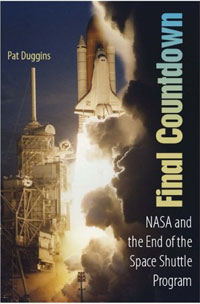|
|
Review: Final Countdown
by Jeff Foust
Monday, April 6, 2009
Final Countdown: NASA and the End of the Space Shuttle Program
By Pat Duggins
University Press of Florida, 2009
softcover, 264 pp., illus.
ISBN 978-0-8130-3384-6
US$19.95
For over five years, we’ve known this day would be coming: some time in late 2010, in all likelihood, the space shuttle will perform its final flight, ending a program that defined NASA’s human spaceflight efforts for decades. While there is a growing push among some members of Congress to extend the life of the shuttle, out of concerns about a gap in human space access as well as the economic fallout of a shuttle shutdown (see “The Constellation squeeze”, The Space Review, this issue), it’s clear than even should such a stay of execution come, the shuttle’s life is nearing its end. The history of the shuttle, and the future of NASA without the shuttle, is recounted in Pat Duggins’s book Final Countdown.
| The biggest critique of the book is its title: while it suggests the book is an examination of the end of the shuttle program and its effects on NASA and the nation, in reality the book is more of a history of the shuttle program. |
Duggins, a NPR reporter in Orlando who has covered NASA and the shuttle program since the Challenger accident in 1986, starts off the book not with the shuttle but with a brief summary of the development of its successor, the Orion crew exploration vehicle and Ares 1 launch vehicle. With that future defined, Duggins provides a high-level history of the shuttle program, from STS-1 through the return to flight following the Columbia accident. Much of this history is told though interviews with and anecdotes from a wide cast of characters, from astronauts to a woman who, as an elementary school student, witnessed the Challenger accident in person.
For those already familiar with the shuttle program, Final Countdown doesn’t provide any new insights, although hearing the story of the shuttle program from the point of view of some lesser-known astronauts and others is enlightening. The biggest critique of the book, though, is its title: while it suggests the book is an examination of the end of the shuttle program and its effects on NASA and the nation, in reality the book is more of a history of the shuttle program, with only a small portion at the beginning and end devoted to the program’s end and the development of Constellation. (The book reviewed here is the softcover edition of a hardcover that came out in 2007; this version includes an updated introduction that discusses the role of space policy in the 2008 presidential campaign.) There’s not much here on the decision to end the shuttle program and its effects on NASA, industry, and places like Florida’s Space Coast, where thousands of workers could lose their jobs when the shuttle retires. That is fodder for a book yet to be written, but likely one that will be, whether the shuttle retires in 2010 or—maybe—a little later.
Jeff Foust (jeff@thespacereview.com) is the editor and publisher of The Space Review. He also operates the Spacetoday.net web site and the Space Politics and Personal Spaceflight weblogs. Views and opinions expressed in this article are those of the author alone, and do not represent the official positions of any organization or company, including the Futron Corporation, the author’s employer.
|
|
